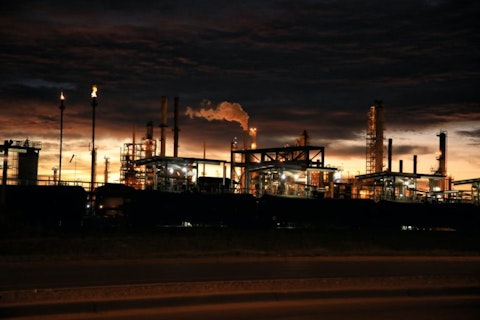In this article, we discuss the top top 20 countries with the highest oil consumption. To skip the detailed analysis and latest updates on the oil industry, go directly to the top 5 countries with the highest oil consumption.
While the world is aiming to move towards renewable energy as fast as possible, oil consumption is still continuing to increase year on year, and oil prices are strong indicators of the world’s economy and where it’s headed. According to the U.S. Energy Information Administration, oil consumption increased by 6.2% from 2020 to 2021, which may be lower than pre-pandemic figures but is still a substantial increase, which bodes well for the highest oil consuming countries.
Even though most countries are enacting laws and regulations, in addition to offering incentives, to move towards renewable energy which is more sustainable in the long term and not as environmentally catastrophic, oil is still a key indicator of the global economy and an important contributor to its output, with the highest oil consuming countries playing a major part. In 2022, when Russia invaded Ukraine, one of the biggest impacts of this war was on oil, and according to NPR “Russia’s war in Ukraine is causing a profound and permanent shift in the world’s oil markets, creating new geopolitical alliances. Analysts say it’s comparable to the 1970s Arab oil embargo.”

Photo by Robin Sommer on Unsplash
The economy of many oil-rich countries depends entirely on their oil production, as evidenced in the 20 countries that have the largest oil reserves, which has allowed nations with otherwise little importance on the global stage to dictate terms and gain influence based on their oil output. And while demand for oil has continued to rise over decades especially as nations with huge populations such as China or India have continued to grow, the long-term challenge for the oil industry comes from developed nations which are aiming to move away from oil, even as global demand doubled in just the last five decades, from 2.3 million tonnes in the early 1970s, to 4.6 million tonnes just before the pandemic, with the countries with the highest oil consumption accounting for a large majority of total consumption. While population definitely has an impact on total consumption by country of oil, industrial nations also tend to consume more oil as compared to those with a sizable agricultural sector.
According to the U.S. Energy Administration, global crude oil reserves are only sufficient to meet demand till 2050, less than three decades from now, unless of course new massive reserves are discovered. This is why countries such as the UAE, which is one of the top oil producing countries in the world, has started to pivot away from just oil and focus more on being a major international tourist destination, attractive to companies as well for its lax tax rules, even though it is not among the countries with the highest oil consumption. Another major concern is economic uncertainty especially in the U.S. amidst a major banking crisis which has led to some of the biggest bankruptcies in U.S. history. This in turn has led to lower capital which is why growth has been curbed in some areas such as the U.S. shale patch, while major oil producers are reluctant to invest more in capex, with some exceptions as we’ll discuss below.
Despite these uncertainties, oil companies enjoyed a bumper 2022 mainly due to prices reaching record highs after Russia invaded Ukraine. The energy crisis resulted in oil and gas companies achieving historic highs in terms of profits including Shell plc (NYSE:SHEL), BP p.l.c. (NYSE:BP), and Exxon Mobil Corporation (NYSE:XOM), which reflected in gains in share price as well, benefitting investors. However, in Europe, a windfall tax was imposed on companies which made historic profits as Europe grappled with a major energy crisis, which finally seems to be under control after a difficult 2022. This resulted in Exxon Mobil Corporation (NYSE:XOM) suing the European Union to block the windfall tax, stating that this would discourage companies from operating in Europe. This was recognized by Deloitte in its 2023 oil and gas industry outlook report where it stated “The oil and gas (O&G) industry earned record profits in 2022, providing ample cash flow to fund their strategies in 2023. And while O&G companies recognize geopolitical and macroeconomic uncertainty in the year ahead, they’ve also been given a clear mandate to secure supply in the short term while transitioning to cleaner energy in the long term. Our 2023 outlook explores five trends that can help shape the path forward for O&G companies.”
This is also why some of these oil companies are taking major steps to increase oil production and supply, with Exxon Mobil Corporation (NYSE:XOM) stating in its Q1 2023 earnings call “Following a record year, ExxonMobil delivered the highest first quarter earnings in our history, even as energy prices and refining margins moderated from the fourth quarter. This ongoing success reflects the hard work of our people, executing our strategic priorities and fully leveraging our competitive advantages. Through investments in advantaged assets, mix improvements, and cost and operating discipline, we are delivering the structural earnings improvements outlined in our corporate plan update last December and expanding the energy supplies needed to meet growing global demand. Compared to the first quarter of 2022, we added about 300,000 oil-equivalent barrels per day to global supply, primarily from a 40% increase in production from Guyana and the Permian Basin. The increase more than offset our divestments in the expropriation of Sakhalin-1, which we no longer account for, but which, importantly, remains part of global supply. In addition, our Beaumont refinery expansion reached nameplate capacity in the quarter. This 250,000 barrels-a-day expansion is the largest U.S. refinery addition in a decade, helping meet society’s ongoing need for transportation fuels. Guyana, we’re pleased to announce that we reached final investment decisions for Uaru, fifth offshore project, which will bring on even more production from this low-cost, low-carbon intensity resource. Uaru will provide an additional 250,000 barrels a day of gross capacity, with start-up targeted for 2026.”
Methodology
The U.S. Energy Information Administration keeps detailed statistics on oil consumption by country, and we obtained data for both 2020 and 2021. The top 20 countries with the highest oil consumption alone accounted for more than three-quarters of the total global oil consumption, and just the top 5 nations accounted for over 50% of total global oil consumption. Unsurprisingly, these are also some of the countries with the biggest populations in the world, while many are well known for their industrial sectors, which are major oil consumers as well. We assigned 70% weightage to 2021 statistics as this provides the latest information and 30% to 2020. So, let’s now take a look at the countries whose economies would plummet with the availability of oil, starting with:
20. Australia
Total consumption in 2020 (million barrels per day): 999
Total consumption in 2021 (million barrels per day): 1,020
We kick off our list with Australia, which is one of the least energy efficient countries in the developed world, with energy consumption per person actually increasing by 0.2% per year.
19. Italy
Total consumption in 2020 (million barrels per day): 1,032
Total consumption in 2021 (million barrels per day): 1,185
According to Clean Energy Wire, the European Union, including Italy, is heavily dependent on imported fossil fuels, including oil, despite sanctions on Russia.
18. Spain
Total consumption in 2020 (million barrels per day): 1,088
Total consumption in 2021 (million barrels per day): 1,188
Spain registered an increase of 9% in oil consumption between 2020 to 2021, earning it a spot on the biggest oil consumers in the world.
17. Thailand
Total consumption in 2020 (million barrels per day): 1,185
Total consumption in 2021 (million barrels per day): 1,192
In 2022, Thailand’s fuel usage increased by 13.5% mainly as a result of full resumption of travel, both by air and by land.
16. United Kingdom
Total consumption in 2020 (million barrels per day): 1,211
Total consumption in 2021 (million barrels per day): 1,258
Data by the Office of National Statistics showed that 42% of adults in the UK reduced their non-essential travel as a result of rising energy costs. While crude oil prices fell later on in August 2022, weakening demand in the UK is still expected to continue.
15. Singapore
Total consumption in 2020 (million barrels per day): 1,277
Total consumption in 2021 (million barrels per day): 1,417
Despite a population of just 5 million people, Singapore is among the highest oil consuming countries in the world, and a 2021 article by Power Engineering International reported that the country was the most dependent on fossil fuels in the world.
14. Mexico
Total consumption in 2020 (million barrels per day): 1,537
Total consumption in 2021 (million barrels per day): 1,544
Pemex, Mexico’s state-owned petroleum company, decided to reduce oil exports in 2022 before entirely phasing them out in 2023 in order to reach self-sufficiency.
13. France
Total consumption in 2020 (million barrels per day): 1,428
Total consumption in 2021 (million barrels per day): 1,548
France has been at the center of massive protests over the last several months over an increase in retirement age from 62 to 64. The protests have resulted in strikes at French ports and oil refineries, the impact of which has been felt across countries and continents, from Africa to America.
12. Indonesia
Total consumption in 2020 (million barrels per day): 1,577
Total consumption in 2021 (million barrels per day): 1,658
Indonesia is the largest importer of motor oil in Asia, and Rystad Energy stated that the nation’s 2023 gasoline demands and imports are both likely to handily beat 2022 numbers.
11. Iran
Total consumption in 2020 (million barrels per day): 1,926
Total consumption in 2021 (million barrels per day): 1,989
Recently, Iran’s oil ministry, the National Iranian Oil Refining and Distribution Company, urged people to reduce their consumption of oil as the country’s oil reserves are depleting.
10. Germany
Total consumption in 2020 (million barrels per day): 2,148
Total consumption in 2021 (million barrels per day): 2,126
Germany is one of the only countries among those with the highest oil consumption which actually saw oil consumption decline, as the country aims to move away from non-renewable energy resources to renewable energy.
9. Canada
Total consumption in 2020 (million barrels per day): 2,171
Total consumption in 2021 (million barrels per day): 2,259
While Canada is already implementing a plan to look beyond oil and gas, especially with Canada’s oil production declining, the country needs to brace for a global decline in oil demand, and plan accordingly.
8. South Korea
Total consumption in 2020 (million barrels per day): 2,448
Total consumption in 2021 (million barrels per day): 2,578
Surprisingly, South Korea is one of the biggest oil consumers in the world, with a heavy reliance on imports from Saudi Arabia.
7. Brazil
Total consumption in 2020 (million barrels per day): 2,790
Total consumption in 2021 (million barrels per day): 2,887
Brazil is one of the few countries which is actually increasing output by 300,000 barrels a day, which according to Bloomsberg is the equivalent of a quarter of the total global increase. However, increasing production while having limited reserves means that Brazil needs to find additional reserves or risk losing influence if its output falls in coming years, though it it still unlikely to drop from the list of highest oil consuming countries in the world anytime soon.
6. Saudi Arabia
Total consumption in 2020 (million barrels per day): 3,314
Total consumption in 2021 (million barrels per day): 3,351
Saudi Arabia is one of the biggest oil producers in the world, which has given it incredible influence on the world stage.
Click to continue reading and see the top 5 countries with the highest oil consumption.
Suggested articles:
- 20 Most Respected Professions in the World
- 10 Undervalued S&P 500 Stocks Billionaires Are Buying
- 10 5G Stocks Billionaires Are Loading Up On
Disclosure: None. Top 20 countries with the highest oil consumption is originally published at Insider Monkey.





